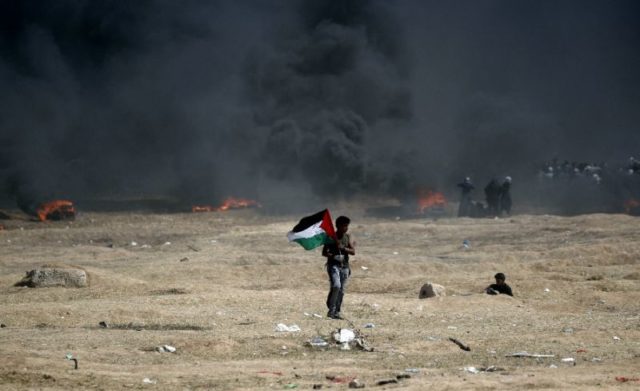A child who has suffered death is always to be mourned; the ruin of another is to be mourned, as well. The stories of Layla and Ammar Ghandour cannot be separated. And neither story can be separated from the vicious way Hamas uses children as both fodder and propaganda. Layla is already both. Ammar is likely to disappear, so it is important to understand his story.
Six-month-old Layla died last week after being at the scene of violent protests at the Gaza-Israel fence. Hamas called for civilians to come as if to a festival and then interspersed its terrorists among the families. Of the 60 or so people who have been killed in the protests, Hamas claims 50 as its operatives and Palestinian Islamic Jihad claims three. But this is about Layla and Ammar. Let’s read what the “New York Times” has to say about the events:
Layla was dozing at their home in Gaza City when a call went up: A bus was waiting, outside a nearby mosque, to take residents to the border fence, where the protest was raging. Her 12-year-old uncle, Ammar, bundled her up in his arms and carried her out the door.
The boy assumed that Layla’s mother was already on the bus. In fact, she was in another part of the house, suffering from a toothache. Still, Layla was hardly the only infant at the protest. Entire families had come along, some snacking on ice cream or sandwiches, as the protests raged hundreds of yards away.
In the late afternoon, Layla, in a tent with her aunts, started to wail. Ammar grabbed his niece for a second time and, he said, pushed forward into the protest in search of her grandmother, Heyam Omar, who was standing in a crowd under a pall of black smoke, shouting at Israeli soldiers across the fence.
Soon after Ms. Omar took the child, she said, a tear-gas canister fell nearby. She frantically wiped the child’s face with water and gave her juice to drink. But an hour later, after they reached the family home, Layla appeared to have stopped breathing.
When they arrived at a hospital at 6:34, doctors pronounced the child dead.
So, what we learned:
- A 12-year-old boy named Ammar took a six-month-old baby named Layla from her bed and onto a Hamas bus.
- Unable to find his mother on the bus, Ammar took Layla to the protests by himself.
- Layla was in a tent with her aunts when she started to cry.
- Ammar took Layla out of the tent, away from the adults, and ran closer to the fence — and the “raging protests” — with her.
- There was tear gas.
- No one took Layla to the ambulances that were stationed near the riots. (You can see the ambulances here and here.) They took her on an hour-long bus ride home.
- Layla was taken to the hospital near her home and pronounced dead.
There are those who say she died of tear gas inhalation and those who say she died of a congenital heart defect. In fact, she died of the combination of Hamas propaganda and a 12-year-old’s enthusiasm, stoked and twisted by terrorists.
Ammar is not old enough to be responsible for the moral implications of his actions. But he is old enough to have attended Hamas schools and summer camps and learned that Israel is illegitimate and will be destroyed by valiant Palestinian children.
Watch Palestinian television, courtesy of the invaluable MEMRI. You can see here — a beautiful child of about seven said he wants to be “an engineer, so that [he] can blow up the Jews.”
Another recited a poem: “I shall liberate [Jerusalem] from the Jews.” Or here, where a preteen host in a kaffiyeh said, fervently, “Glory and eternity to our pure martyrs. We salute their families, and we revere the young heroes who have sacrificed their lives for Jerusalem, and who carried out all those great heroic acts. We love them and kiss their hands because they are true heroes. We say to all the Palestinian mujahideen: Oh mujahideen, keep your shoes because the day will come when all the museums of the world will want to exhibit them.”
A boy responds, “The Israelis fight with missile and tanks, but we fight with stones. We are not afraid. They are more afraid than us. They love life.” As if it is a bad thing.
By the time he reached the tender age of 12, Ammar thought he knew that, for Palestinians, life is something to throw at the Jews. He probably didn’t mean to throw Layla’s life.
What will Ammar be when he reaches an age when he might have a more mature understanding of the abuse that was perpetrated on him by Hamas and how Layla paid for that? Will he feel guilty about Layla? What will he do about it? Will he try to atone by dying in jihad or — one can hope — by renouncing the violence and hatred that marked his childhood?
We are unlikely to know, because while Hamas is happy to praise dead people and broadcast their pictures, it is unlikely to make a hero of a child who took a baby from her home to a violent rampage from which she returned dead and he alive.
In a very real way, two children lost their lives that day and both should be mourned. The horror the world feels should be laid directly at the feel of their killer, Hamas.


